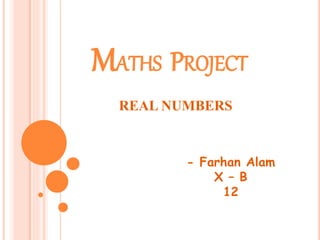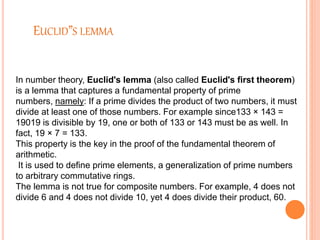Real numbers
- 1. MATHS PROJECT REAL NUMBERS - Farhan Alam X – B 12
- 2. REAL NUMBERS In mathematics, a real number is a value that represents a quantity along a continuous line. The real numbers include all the rational numbers, such as the integer −5 and the fraction 4/3, and all the irrational numbers such as √2 (1.41421356…, the square root of two, an irrational algebraic number) and π (3.14159265…, atranscendental number)
- 3. HISTORY OF REAL NUMBERS Simple fractions have been used by the Egyptians around 1000 BC; the Vedic "Sulba Sutras" ("The rules of chords") in, c. 600 BC, include what may be the first "use" of irrational numbers. The concept of irrationality was implicitly accepted by early Indian mathematicians since Manava (c. 750–690 BC), who were aware that the square roots of certain numbers such as 2 and 61 could not be exactly determined. Around 500 BC, the Greek mathematicians led by Pythagoras realized the need for irrational numbers, in particular the irrationality of the square root of 2. The Middle Ages brought the acceptance of zero, negative, integral, and fractional numbers, first by Indian and Chinese mathematicians, and then by Arabic mathematicians, who were also the first to treat irrational numbers as algebraic objects, which was made possible by the development of algebra. Arabic mathematicians merged the concepts of "number" and "magnitude" into a more general idea of real numbers. The Egyptian mathematician Abū Kāmil Shujā ibn Aslam (c. 850– 930) was the first to accept irrational numbers as solutions to quadratic equations or as coefficients in an equation, often in the form of square roots, cube roots and fourth roots
- 4. Euclid Euclid , also known as Euclid of Alexandria, was a Greek mathematician, often referred to as the "Father of Geometry". He was active in Alexandria during the reign of Ptolemy I (323–283 BC). His Elements is one of the most influential works in the history of mathematics, serving as the main textbook for teaching mathematics (especially geometry ) from the time of its publication until the late 19th or early 20th century. In the Elements, Euclid deduced the principles of what is now called Euclidean geometry from a small set of axioms. Euclid also wrote works on perspective, conic sections, spherical geometry, number theory and rigor.
- 5. Hippasus Hippasus of Metapontum was a Pythagorean philosopher. Little is known about his life or his beliefs, but he is sometimes credited with the discovery of the existence of irrational numbers. The discovery of irrational numbers is said to have been shocking to the phythagoreans, and Hippasus is supposed to have drowned at sea, apparently as a punishment from the gods, for divulging this. However, the few ancient sources which describe this story either do not mention Hippasus by name or alternatively tell that Hippasus drowned because he revealed how to construct a dodecahedron inside a sphere. The discovery of irrationality is not specifically ascribed to Hippasus by any ancient writer. Some modern scholars though have suggested that he discovered the irrationality of √2, which it is believed was discovered around the time that he lived.
- 6. EUCLID”S LEMMA In number theory, Euclid's lemma (also called Euclid's first theorem) is a lemma that captures a fundamental property of prime numbers, namely: If a prime divides the product of two numbers, it must divide at least one of those numbers. For example since133 × 143 = 19019 is divisible by 19, one or both of 133 or 143 must be as well. In fact, 19 × 7 = 133. This property is the key in the proof of the fundamental theorem of arithmetic. It is used to define prime elements, a generalization of prime numbers to arbitrary commutative rings. The lemma is not true for composite numbers. For example, 4 does not divide 6 and 4 does not divide 10, yet 4 does divide their product, 60.
- 7. Remarks 2) Although Euclid’s divison algorithm is stated for only positive integers, it can be extended for all integers except zero ,i.e.b 0 1) Euclid’s divison lemma and algorithm are so closely interlinked that people often Call former as the divison algorithm also.
- 8. FUNDAMENTAL THEOREM OF ARITHMETIC In number theory, the fundamental theorem of arithmetic, also called the unique factorization theorem or the unique-prime-factorization theorem, states that every integer greater than 1 either is prime itself or is the product of prime numbers, and that, although the order of the primes in the second case is arbitrary, the primes themselves are not. For example, 1200 = 24 × 31 × 52 = 3 × 2× 2× 2× 2 × 5 × 5 = 5 × 2× 3× 2× 5 × 2 × 2 = etc. The theorem is stating two things: first, that 1200 can be represented as a product of primes, and second, no matter how this is done, there will always be four 2s, one 3, two 5s, and no other primes in the product. The requirement that the factors be prime is necessary: factorizations containing composite numbers may not be unique (e.g. 12 = 2 × 6 = 3 × 4).
- 9. PRIME FACTORISATION Find the HCF and LCM of 24 and 40 24 = 2 x 3 x 2 x 2 and 40 = 2 x 2 x 2 x 5 HCF: The common factors of 24 and 40 are 2 x 2 x 2 = 8. So the HCF and LCM of 24 and 40 = 8 LCM: We take the prime factors of the smaller number (24), and they are 2, 3, 2, and 2. The only prime factor from the larger number (40) not in this list is 5. So the LCM of 24 and 40 is 2 x 3 x 2 x 2 x 5 = 120
- 10. REVISITING IRRATIONAL NUMBERS Show that 5 – √3 is irrational. That is, we can find coprime a and b (b ≠ 0) such that Therefore, Rearranging this equation, we get Since a and b are integers, we get is rational, and so √3 is rational. But this contradicts the fact that √3 is irrational. This contradiction has arisen because of our incorrect assumption that 5 – √3 is rational. So, we conclude that 5 − √3 is irrational. Let us assume, to the contrary, that 5 – √3 is rational.
- 11. REVISITING RATIONAL NUMBERS AND THEIR DECIMAL EXPANSIONS Rational numbers are of two types depending on whether their decimal form is terminating or non terminating A decimal number that has digits that do not go on forever. Examples: 0.25 (it has two decimal digits) 3.0375 (it has four decimal digits) In contrast a Recurring Decimal has digits that go on forever Example: 1/3 = 0.333... (the 3 repeats forever) is a Recurring Decimal, not a Terminating Decimal Terminating Non - Terminating a decimal numeral that does not end in an infinite sequence of zeros (contrasted with terminating decimal ).











